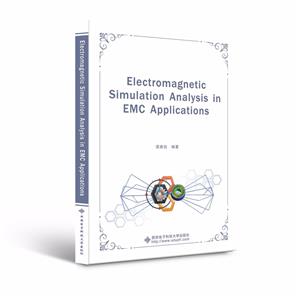扫一扫
关注中图网
官方微博
本类五星书更多>
-
>
公路车宝典(ZINN的公路车维修与保养秘籍)
-
>
晶体管电路设计(下)
-
>
基于个性化设计策略的智能交通系统关键技术
-
>
花样百出:贵州少数民族图案填色
-
>
山东教育出版社有限公司技术转移与技术创新历史丛书中国高等技术教育的苏化(1949—1961)以北京地区为中心
-
>
铁路机车概要.交流传动内燃.电力机车
-
>
利维坦的道德困境:早期现代政治哲学的问题与脉络
Electromagnetic simulation analysis in EMC application 版权信息
- ISBN:9787560660677
- 条形码:9787560660677 ; 978-7-5606-6067-7
- 装帧:一般胶版纸
- 册数:暂无
- 重量:暂无
- 所属分类:>
Electromagnetic simulation analysis in EMC application 内容简介
本书重点介绍了电磁仿真分析的基础知识以及利用其具体知识进行电磁兼容仿真应用的方法,书中内容全面丰富、深入浅出,既有理论与原理阐述,又有工程应用中复杂问题的分析解决实例,具有较强的可读性和实用性,可帮助读者理解并掌握电磁仿真分析在复杂电磁环境应用中所涉及的基本概念、基本原理和基本方法。 本书共4章,内容分别为电磁兼容中的电磁仿真分析、电磁仿真分析基本原理、电磁兼容基础、电磁兼容仿真分析的典型应用等,各章后均附有思考题。本书可供电子信息工程、电磁场与无线技术、遥感技术及应用、电子与通信工程、仪器与测试技术、电气工程等电气信息类相关专业师生使用,也可供电子、兵器、航空、航天等相关领域的工程技术人员参考。
Electromagnetic simulation analysis in EMC application 目录
Chapter 1 Electromagnetic simulation analysis in EMC
1.1 Introduction
1.2 Analysis of electromagnetic simulation
1.3 Theoretical foundation for electromagnetic simulation analysis
1.3.1 Physical theories of electromagnetic analysis
1.3.2 Mathematical theories of electromagnetic analysis
1.3.3 Guidance for numerical analysis
1.4 Introduction of electromagnetic simulation software
1.4.1 CST software
1.4.2 FEKO software
1.4.3 HFSS software
1.4.4 ADS software
1.4.5 Simple examples of electromagnetic simulation analysis
Thinking questions
Chapter 2 Basic principles of electromagnetic simulation analysis
2.1 Systematic community in EMC simulation analysis
2.2 Introduction of Methods for EMC simulation analysis
2.3 Method of separation of variables
2.3.1 Basis of method of separation of variables
2.3.2 Application of method of separation of variables
2.4 Finite difference method
2.4.1 Derivation of finite difference equation
2.4.2 Discretization of problem region to be solved
2.4.3 Treatment of boundary conditions and calculating formulation
2.4.4 Application of finite difference method
2.5 Finite difference time domain method
2.5.1 Introduction to time domain
2.5.2 Basis of finite difference time domain method
2.5.3 1-D formulation of finite difference time domain method
2.5.4 2-D formulation of finite difference time domain method
2.5.5 Numerical stability and dispersion
2.5.6 Absorbing boundary condition
2.5.7 Excitation and field region constitution
2.6 Method of moments
2.6.1 Basis of method of moments and its applications
2.6.2 Impedance theory in method of moments
2.6.3 Generalization for method of moments
2.7 Variational method
2.7.1 Mathematical basis of variational method
2.7.2 Definition of variation
2.7.3 Euler-Lagrange equation as the simplest functional
2.7.4 Solutions of typical variational problems
2.7.5 Several techniques for solving differential equations in variation
2.7.6 Rayleigh-Ritz method in variation
2.7.7 Example of electromagnetic variation
2.8 Finite element method
2.8.1 Variational basis of finite element method
2.8.2 Basic steps in finite element method
2.8.3 Basic formulation of finite element method
2.8.4 Electromagnetic formulation of finite element method
2.9 Monte Carlo method
2.9.1 Basic concepts and processes in Monte Carlo method
2.9.2 Application basis of Monte Carlo method
2.9.3 Characteristics of Monte Carlo method
2.9.4 Special applications of numerical integration
2.9.5 Electromagnetic analysis with Monte Carlo method
2.10 High frequency method
2.11 Finite integration time domain method
2.12 Transmission line matrix method
2.13 Introduction of multi-physical field coupling
Thinking questions
……
Chapter 3 Basis of EMC
Chapter 4 Typical applications of EMC simulation analysis
References
1.1 Introduction
1.2 Analysis of electromagnetic simulation
1.3 Theoretical foundation for electromagnetic simulation analysis
1.3.1 Physical theories of electromagnetic analysis
1.3.2 Mathematical theories of electromagnetic analysis
1.3.3 Guidance for numerical analysis
1.4 Introduction of electromagnetic simulation software
1.4.1 CST software
1.4.2 FEKO software
1.4.3 HFSS software
1.4.4 ADS software
1.4.5 Simple examples of electromagnetic simulation analysis
Thinking questions
Chapter 2 Basic principles of electromagnetic simulation analysis
2.1 Systematic community in EMC simulation analysis
2.2 Introduction of Methods for EMC simulation analysis
2.3 Method of separation of variables
2.3.1 Basis of method of separation of variables
2.3.2 Application of method of separation of variables
2.4 Finite difference method
2.4.1 Derivation of finite difference equation
2.4.2 Discretization of problem region to be solved
2.4.3 Treatment of boundary conditions and calculating formulation
2.4.4 Application of finite difference method
2.5 Finite difference time domain method
2.5.1 Introduction to time domain
2.5.2 Basis of finite difference time domain method
2.5.3 1-D formulation of finite difference time domain method
2.5.4 2-D formulation of finite difference time domain method
2.5.5 Numerical stability and dispersion
2.5.6 Absorbing boundary condition
2.5.7 Excitation and field region constitution
2.6 Method of moments
2.6.1 Basis of method of moments and its applications
2.6.2 Impedance theory in method of moments
2.6.3 Generalization for method of moments
2.7 Variational method
2.7.1 Mathematical basis of variational method
2.7.2 Definition of variation
2.7.3 Euler-Lagrange equation as the simplest functional
2.7.4 Solutions of typical variational problems
2.7.5 Several techniques for solving differential equations in variation
2.7.6 Rayleigh-Ritz method in variation
2.7.7 Example of electromagnetic variation
2.8 Finite element method
2.8.1 Variational basis of finite element method
2.8.2 Basic steps in finite element method
2.8.3 Basic formulation of finite element method
2.8.4 Electromagnetic formulation of finite element method
2.9 Monte Carlo method
2.9.1 Basic concepts and processes in Monte Carlo method
2.9.2 Application basis of Monte Carlo method
2.9.3 Characteristics of Monte Carlo method
2.9.4 Special applications of numerical integration
2.9.5 Electromagnetic analysis with Monte Carlo method
2.10 High frequency method
2.11 Finite integration time domain method
2.12 Transmission line matrix method
2.13 Introduction of multi-physical field coupling
Thinking questions
……
Chapter 3 Basis of EMC
Chapter 4 Typical applications of EMC simulation analysis
References
展开全部
书友推荐
本类畅销
-
5G承载网技术及部署(微课版)
¥32.4¥49.8 -
半导体制造技术导论(第二版)
¥61.4¥99 -
FX系列PLC的链接通信及VB图形监控
¥24.4¥39 -
固态电子器件-(第七版)
¥69.7¥109 -
全彩电子元器件、万用表和示波器自学一本通(微视频版)
¥72.3¥99 -
ANSYS电磁兼容仿真与场景应用案例实战
¥70.9¥109
浏览历史
商用车技术:原理、系统和部件
¥52.5¥150.0大学俄语东方(新版)(1)(教师)
¥34.6¥42.0览观其意:文徵明书画艺术探微
¥98.0¥200.0和孩子一起玩的节日游戏书(全两册)
¥55.9¥99.8交响乐欣赏十八讲
¥25.7¥45.0

















